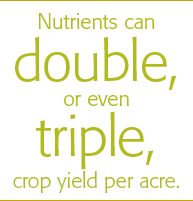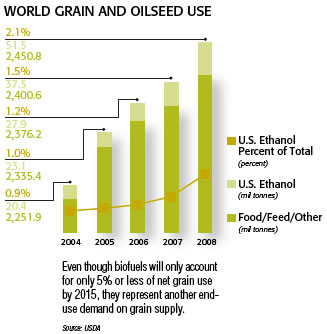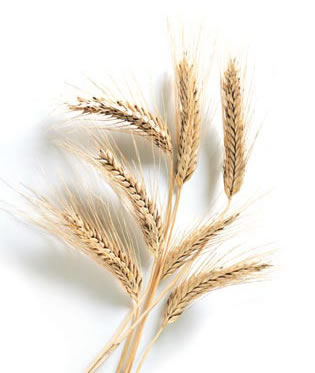
Increasing crop yields is the key to growing the larger harvests needed to meet accelerating demand.

The world has used more grains and oilseeds than it has produced in seven of the last eight years due to both an acceleration in the pace of demand growth, as well as a significant slowdown in yield growth. In fact, global grain and oilseed stocks as a percentage of use will drop to the lowest level in 35 years at the end of the 2007-2008 crop year. Grain and oilseed prices have surged in response to low inventories. Markets are asking farmers to rev up the powerful engines of production agriculture in order to meet accelerating demand.
"We like to use a metaphor of an engine to describe recent developments in agricultural commodity markets. Markets are asking farmers around the world to rev up the engines of production agriculture in order to meet accelerating demand growth. Our assessment is that these powerful engines have plenty of RPMs and plenty of horsepower left – with current technologies – to increase grain and oilseed production and meet demand."
Reversing Yield Trends
Crop yields today are increasing at a slower rate than in the past. For example, the world average wheat yield increased at a compound annual growth rate of 2.6% from 1970 to 1990. Yield growth slowed to 1.1% per year in the 1990s and has decelerated to just 0.7% per year so far this decade. Corn, rice and soybeans exhibit similar trends.
Yield growth has slowed because the world simply is not
investing sufficient capital in the agricultural sector to maintain
the impressive productivity growth of the 1970s and 1980s. The
world took for granted that large surpluses that plagued global
agriculture in the past would continue to overhang these markets
far into the future. The World Bank earlier this year acknowledged
that agriculture had slipped down its priority list during the last
several years and pledged to double agricultural lending
to Africa.
Investment is needed to get yield growth back on track. These investments range from infrastructure, such as irrigation systems, to the widespread use of best practices, such as balanced crop nutrient use. The rapid adoption of modern technologies, such as GMO seed varieties, and institutional reforms, such as the development of viable credit and commodity markets, also can lead to enhanced agricultural production.

Crop Nutrients As Part of the Solution
Crop nutrients are part of the yield solution. Agronomists estimate that commercial crop nutrients directly account for 40% to 60% of crop yields. The optimum use of crop nutrients in a high-yield cropping system is key to increasing agricultural productivity growth.
Much like farmers around the globe, crop nutrient producers also have struggled to meet the accelerating nutrient demand growth. Thin margins and poor earnings for most of the last two decades resulted in reduced capital investment, as well as the closing of less efficient facilities. As a consequence, the industry was not well equipped to meet the recent surge in crop nutrient demand. In fact, global nutrient use is projected to increase 13%, or more than 20 million tonnes, from 2006 through 2008. This is the equivalent of adding the United States' usage to global demand in just three years.

Given the positive long-term demand outlook, Mosaic is moving boldly to bring additional potash capacity online over the next several years, exploring new sources of phosphate rock in order to boost phosphate production, as well as streamlining processes for optimum efficiencies.
A New Era of Agriculture
Given the sustained growth in population and income, the world will continue to demand more food and energy. Agriculture must enter a new era. Just as it did during the Green Revolution of the 1960s and 1970s, the industry will turn to science and technology to discover new and better ways to boost food production. New crop varieties, technologies that increase drought tolerance and more effective and balanced crop nutrient application are just a few of the ways participants will plot the second Green Revolution – a revolution that will keep supply in step with accelerating demand growth.